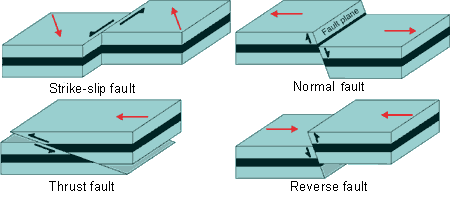MITIHANI POPOTE: FAULTING & FOLDING
-
Explain the landforms formed by faulting process
The faulting process creates various landforms including:
- Block mountains (horsts)
- Rift valleys (grabens)
- Fault scarps
- Tilted blocks
- Fault-line scarps
-
Explain the effects of diastrophism to the earth crust
Diastrophism affects the Earth's crust by:
- Creating folds and faults in rock layers
- Causing uplift or subsidence of crustal blocks
- Forming mountains and basins
- Generating earthquakes
- Changing the elevation of land surfaces
-
Landform is a function of process, structure and stages explain
This concept means that landforms result from:
- Process: The geomorphic agents (water, wind, ice) that shape the land
- Structure: The underlying rock type and arrangement
- Stage: The time duration and developmental phase of the landform
These three factors interact to determine the final form of any landscape feature.
-
Explain how faulting can affect river systems and drainage patterns
Faulting impacts river systems by:
- Creating new channels along fault lines
- Causing stream capture through elevation changes
- Forming linear valleys that guide river courses
- Creating waterfalls at fault scarps
- Producing rectangular drainage patterns along fault systems
- Blocking existing rivers to form lakes
FAULTING & FOLDING
-
Explain the landforms formed by faulting process
The faulting process creates various landforms including:
- Block mountains (horsts)
- Rift valleys (grabens)
- Fault scarps
- Tilted blocks
- Fault-line scarps
-
Explain the effects of diastrophism to the earth crust
Diastrophism affects the Earth's crust by:
- Creating folds and faults in rock layers
- Causing uplift or subsidence of crustal blocks
- Forming mountains and basins
- Generating earthquakes
- Changing the elevation of land surfaces
-
Landform is a function of process, structure and stages explain
This concept means that landforms result from:
- Process: The geomorphic agents (water, wind, ice) that shape the land
- Structure: The underlying rock type and arrangement
- Stage: The time duration and developmental phase of the landform
These three factors interact to determine the final form of any landscape feature.
-
Explain how faulting can affect river systems and drainage patterns
Faulting impacts river systems by:
- Creating new channels along fault lines
- Causing stream capture through elevation changes
- Forming linear valleys that guide river courses
- Creating waterfalls at fault scarps
- Producing rectangular drainage patterns along fault systems
- Blocking existing rivers to form lakes


No comments
Post a Comment